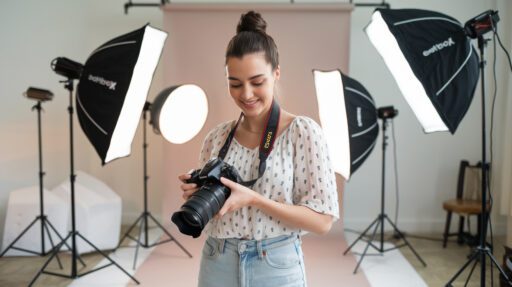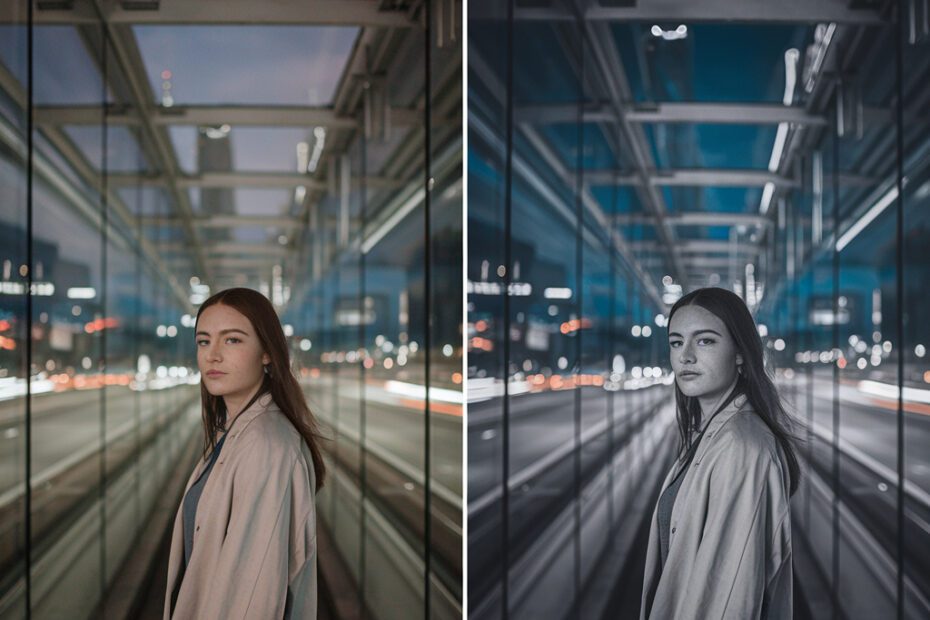Mastering portrait photography doesn’t require years of experience or expensive gear. With a few key techniques, anyone can capture professional-looking portraits. Whether you’re using a smartphone or a DSLR, these 10 essential portrait photography tips will help you take stunning, high-quality portraits that are sure to impress.
1. Use What You Have: Portrait Photography Tips for Beginners

You don’t need top-tier equipment to capture beautiful portraits. The tools you already have can deliver impressive results with the right approach. For instance, if you’re using a smartphone, make the most of features like portrait mode, which mimics the depth of field created by professional cameras. By following these portrait photography tips, you can maximize your equipment’s potential, no matter what you’re using. Position your subject a few feet from the background and focus on lighting to elevate your shots.
For beginner DSLR users, consider investing in a 50mm prime lens, often referred to as the “nifty fifty.” It’s affordable and allows you to shoot with a wide aperture (e.g., f/1.8), creating a pleasing background blur (bokeh) that puts all the attention on your subject. Even in low light, this lens can capture sharp images, making it a versatile tool in your kit.
While professional cameras and lenses offer more control, these portrait photography tips help you get the most out of whatever gear is at your disposal.
2. Lighting Matters: Natural vs. Artificial Light in Portrait Photography

Lighting plays a pivotal role in determining the quality of your portraits. Natural light is often the easiest and most flattering for beginners. Shooting outdoors during the golden hour—right after sunrise or just before sunset—creates soft, warm light that enhances skin tones and adds depth to your portraits. Simple portrait photography tips, like using golden hour lighting, can instantly improve your results. If you’re indoors, position your subject near a large window to take advantage of diffused natural light. A trick to soften harsh shadows on a bright day is to use a thin curtain or sheet over the window, diffusing the light onto your subject.
Artificial light, on the other hand, offers more control over the lighting environment. Using tools like softboxes or continuous LED lights helps to direct and diffuse light, creating consistent results even when natural light is unavailable. Place the light source at a 45-degree angle from your subject for a flattering effect. If you’re on a budget, household lamps can also work—just remember to soften the light using a lampshade or by bouncing it off a white wall to avoid harsh shadows.
The balance between natural and artificial light depends on the environment, but mastering both will give you the flexibility to shoot portraits in any setting.
3. Posing Tips for Flattering Portraits

Posing your subject effectively can make a world of difference in the final portrait. Often, people feel uncomfortable in front of the camera, leading to stiff, awkward poses. but applying some basic portrait photography tips can help them relax. As a photographer, it’s your job to make them feel at ease. Start by engaging in light conversation to build rapport and relax your subject. When your subject feels comfortable, they’ll pose more naturally.
For flattering portraits, have your subject turn their body slightly away from the camera while keeping their face turned toward the lens. This slight angle creates a more dynamic composition and often results in a slimming effect. Encourage your subject to shift their weight onto one leg or lean slightly forward to appear more engaged with the camera.
If you’re photographing someone who’s not accustomed to posing, give them something to do with their hands—whether it’s resting them on their hip, holding a prop, or gently touching their face. Hands can be a challenge in portrait photography, but proper hand placement makes your subject appear more natural and less rigid.
For group portraits, guide your subjects into poses that overlap slightly to create a sense of connection and intimacy. Ensuring your subjects aren’t too far apart will keep the portrait feeling cohesive.
4. Master Camera Settings: Essential Portrait Photography Tips
A well-executed portrait relies heavily on understanding your camera’s settings. The three main settings you’ll need to control are aperture, shutter speed, and ISO. These elements work together to determine how much light enters the camera, how much of the scene is in focus, and how sharp your final image will be.
Start by setting your aperture. For portraits, using a wide aperture (low f-stop number like f/1.8 or f/2.8) will create a shallow depth of field, meaning your subject will be sharp while the background is softly blurred. This technique isolates your subject and draws attention to their face. A wide aperture also allows more light into the lens, which is especially helpful in low-light conditions.
Next, adjust your shutter speed. When photographing people, a faster shutter speed (at least 1/125 seconds) is essential to avoid motion blur. This is particularly important if your subject is moving or you’re shooting handheld. If you’re shooting in lower light conditions, you may need to lower your shutter speed or increase your ISO to keep the image properly exposed.
Finally, set your ISO. Keeping the ISO low (e.g., 100-400) will produce the cleanest image with minimal noise. However, in darker environments, you may need to increase the ISO. Be cautious, though—higher ISO settings can introduce grain into your image, which might not be desirable in portraits.
By mastering these basic settings, you’ll have much greater control over how your portraits turn out.
5. Choosing the Right Background for Portraits

While your subject is the focal point, the background plays a crucial role in enhancing (or detracting from) the overall impact of the portrait. A cluttered or busy background can pull focus away from your subject, while a simple, clean backdrop ensures all attention is on them.
For outdoor portraits, natural settings like parks, beaches, or forest trails offer a variety of simple yet dynamic backdrops. Just make sure the background doesn’t overpower the subject. Position your subject a few feet away from the background to create depth and allow the background to blur slightly if you’re using a wide aperture.
For indoor shoots, a plain wall or neutral-colored fabric works well. If you’re working in a cluttered space, positioning your subject closer to the camera and farther from the background helps blur any distractions. A wide aperture will also help here, blurring out the details that might compete for attention in the frame.
When you don’t have control over the environment, such as in street photography, you can use a shallow depth of field to throw the background out of focus and keep the emphasis on your subject.
6. Avoid Common Mistakes: Quick Fixes for Better Portraits
Even experienced photographers can make mistakes, but knowing how to avoid or quickly fix them will elevate your portraits. One common mistake is blurry images caused by too slow of a shutter speed. To fix this, ensure your shutter speed is fast enough—at least 1/125 seconds for handheld shots. If you’re shooting in lower light, increase your ISO or use a tripod to stabilize the camera.
Unflattering poses can also be an issue. If your subject appears stiff or unnatural, try directing them into more comfortable positions. For instance, having them shift their weight onto one leg or slightly lean forward can create a more dynamic and natural-looking pose. Encourage them to relax their facial expressions or gently tilt their head to add variation and personality to the shot.
Harsh lighting is another challenge that can be easily fixed. If you’re shooting outdoors on a sunny day, the sunlight might cast harsh shadows on your subject’s face. In this case, move them into the shade or use a reflector to bounce light back onto their face, softening the shadows.
By addressing these common issues as they arise, you’ll be able to capture more consistent and professional-looking portraits. Whether you’re shooting portraits or landscapes, common mistakes can ruin an otherwise perfect shot. For tips on getting it right in outdoor environments, check out this guide on nature photography.
7. Capture Stunning Portraits with Minimal Gear

You don’t need a studio full of expensive gear to take amazing portraits. A simple camera and one or two lenses can produce excellent results. A 50mm lens is often the best option for portrait photographers due to its ability to create sharp images with a soft, out-of-focus background (bokeh). Its focal length closely mimics what the human eye sees, making portraits look natural and pleasing.
When shooting with minimal gear, natural light is your best friend. If you’re shooting indoors, positioning your subject near a large window provides soft, diffused light that flatters the face and minimizes harsh shadows. Outdoors, the golden hour offers the best light, but shooting in shaded areas can also work well.
Even if you only have a smartphone or a basic camera, focusing on composition, lighting, and your subject’s pose will help you capture high-quality images without the need for advanced equipment.
8. Understanding Camera Settings for Better Results
To consistently capture great portraits, it’s essential to master your camera settings. Using a wide aperture (f/1.8 to f/2.8) creates a shallow depth of field, blurring the background and putting the focus on your subject. For sharper portraits, keep your shutter speed at 1/125 seconds or faster. If you’re shooting in low light, raising your ISO to 400 or 800 ensures the image is properly exposed without too much grain.
Even smartphones have manual settings or portrait modes that adjust aperture and shutter speed automatically. If you’re using a smartphone, tap on your subject’s face to focus and lock the exposure. This will ensure that the subject is well-lit and in sharp focus.
9. Post-Processing for Perfect Portraits
Retouching tools in editing software like Lightroom or Photoshop can help remove blemishes and smooth skin, but use these tools sparingly to keep your subject looking natural. Subtle portrait photography tips can enhance post-processing techniques, especially when balancing sharpness and natural textures. Over-editing can make the portrait look artificial, so focus on subtle adjustments. You can reduce skin imperfections, but maintain the natural texture of the skin to avoid a “plastic” appearance.
Sharpening is another important step in post-processing. Make sure your subject’s eyes are sharp and in focus, as the eyes are often the focal point of a portrait. Adjusting sharpness specifically around the eyes can make the portrait more engaging and bring life to the image.
If you’re using free tools like Snapseed or GIMP, you can still achieve great results. Focus on basic adjustments like contrast, brightness, and color balance to enhance the overall look. Even small changes in post-processing can make a huge difference in the final quality of your portrait.
Lastly, consider cropping your photo to improve composition. The rule of thirds is a good guideline to follow—position your subject’s eyes along the upper third of the frame for a balanced and engaging portrait. Cropping can also eliminate distractions around the edges of the photo, keeping the focus on your subject.
10. Practice, Practice, Practice!

As with any skill, practice is essential to improving your portrait photography. The more you shoot, the more confident you’ll become in handling different situations and settings. Don’t be afraid to experiment with various lighting conditions, camera settings, and poses. Incorporating these portrait photography tips into your practice sessions will help you refine your skills faster.
Start by practicing with friends or family members to get comfortable directing your subjects and trying out different angles. Pay attention to how light affects your shots throughout the day, and experiment with shooting in different environments, such as outdoor natural light, indoor artificial light, or low-light settings.
To take your skills to the next level, try working on a personal project where you shoot a series of portraits with a specific theme, such as capturing different emotions or focusing on environmental portraits in various locations. This will help you refine your technical skills while also exploring creative ideas.
The more you practice, the more natural it will feel to apply these portrait photography tips, and soon you’ll see noticeable improvements in the quality of your work. Remember, even professional photographers started somewhere, and consistent practice is what helps you master the art of portrait photography.
By applying these 10 essential portrait photography tips, you’ll be well on your way to capturing professional-looking portraits that showcase your subjects beautifully. Whether you’re using a smartphone, an entry-level DSLR, or advanced equipment, these techniques will help you create stunning portraits that leave a lasting impression. So grab your camera, start practicing, and watch your photography skills grow
